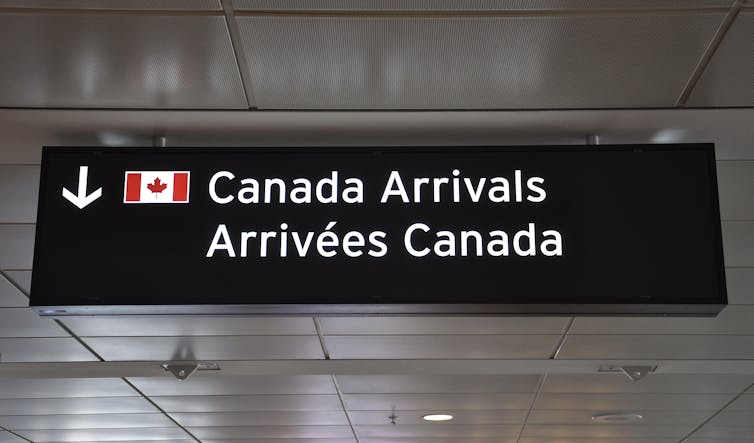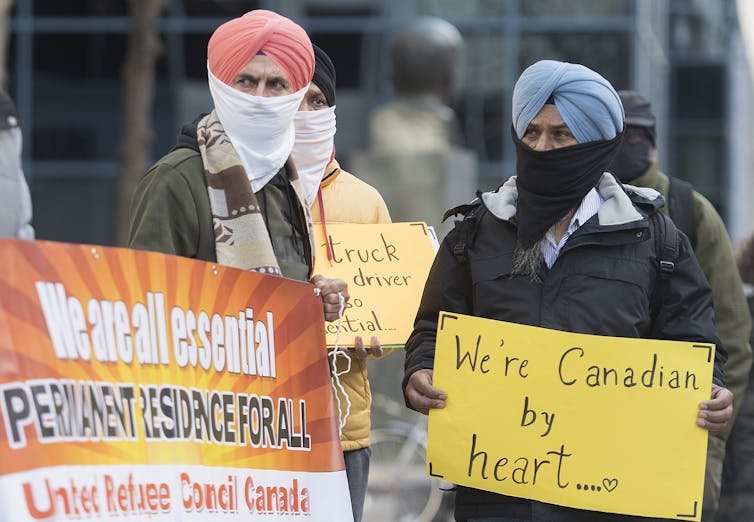
Ashika Niraula, Toronto Metropolitan University and Rica Agnes Castaneda, Toronto Metropolitan University
Canada has long relied on strong immigration to fulfil the country’s demographic needs, expand its economy and support regional development.
In 2021, the country surpassed its ambitious immigration target, admitting more than 405,000 permanent residents amid the COVID-19 pandemic. That was mainly achieved through two temporary measures: the TR (Temporary Resident) to PR (Permanent Resident) pathway and amendments to the Express Entry program.
These measures were part of a two-step immigration selection approach that facilitated transitions from temporary to permanent status for thousands of temporary migrants already in Canada. Two-step immigration refers to the process by which temporary migrant workers can apply to become permanent residents.
Now, the question is: how did these temporary programs impact the lives of temporary work permit-holders and international graduates? And what lessons can be learned from these programs as Canada aims to welcome 500,000 immigrants a year by 2025?
Flexibility and compassion
A strong economic rationale for increased immigration and greater flexibility for international students has resulted in Canada becoming an attractive study destination.
Our ongoing study on skilled migrants and international students’ migration-related decision-making has found that they appreciated the nimbler and more adaptable two-step immigration approach taken by Immigration, Refugees and Citizenship Canada (IRCC) since the onset of the pandemic.
Immigrant-friendly policy changes during the pandemic — compared to countries like Australia and the United States — have given Canada an edge in the race to attract skilled migrants.

Perpetuating a dubious promise
But despite its positive attributes, our findings show that two-step immigration often creates unrealistic expectations among many international students and skilled temporary foreign workers. It perpetuates the idea that everyone with temporary residence in Canada could receive permanent residence.
Many international students, drawn by Canada’s immigrant-friendly reputation and the perceived ease of obtaining permanent residence, spend huge amounts of money to come here. That includes paying thousands of dollars per year on tuition, housing and other expenses.
The TR to PR pathway created a sense of relief for many immigrants and international students. Many became eligible to apply for permanent residence thanks to its relatively lenient language and work requirements.
However, it also caused frustration. Potential applicants lacked clear information about the application process. Many potential applicants struggled to obtain the required documents like language test results on time. A rush to book appointments caused testing centre websites to crash.
Furthermore, the requirement of one year of full-time work experience for health care and other essential workers, along with the high application fees, might have resulted in a low number of applications.
Issues continue after settling in
Immigrants continue to face challenges even after they attain permanent residence. Finding affordable housing in many cities is a growing challenge for Canadians, newly landed immigrants and international students alike.
A housing crisis has placed newcomers at even more of a disadvantage. Sub-par living conditions and soaring rental costs have left many struggling to find decent accommodation.
Mental health is another issue that needs to be addressed. Many international students who took part in our study spoke about feeling left out in their institutions, especially during the pandemic.
While many Canadian students were able to go home to their families during the switch to virtual classes, international students were often left even more isolated. In addition, border closures and travel restrictions meant many migrants had not been home or seen their families in more than two years.
Ethical immigration policies
As Canada increases immigration over the next few years, there is a need to embrace policies and programs that fulfil immigration targets in an ethical way. Future transition programs could be better designed, eliminating a limited application time frame and quota system.

IRCC is currently struggling with staggering backlogs of more than two million applicants. The department needs to improve processing times based on the urgency of the applications it receives.
IRCC must also be transparent. It needs to disclose information about what types of applications they would prioritize and publish a timetable for Express Entry draws indicating which immigration programs they would focus on in upcoming rounds of invitations. That would provide potential applicants ample time to prepare, as well as reduce wait-induced anxieties.
The transition measures introduced during the pandemic provided greater certainty for international students, essential workers and skilled foreign workers. However, applicants in other schemes, low-skilled immigrants, those applying from abroad and those with undocumented status still face significant challenges and uncertainty.
Post-grad work
Studying in a Canadian educational institution allows many international students to be eligible for a post-graduation work permit. However, there is no guarantee they will find employment that allows them to be eligible for permanent residence.
Canada must view international students as future highly skilled members of the workforce and not just as “cash cows.”
More labour market integration programs should be set up to connect international graduates with employers in their field or study. There is a need for a guaranteed pathway to permanent residence to better secure international graduates’ futures.
Institutional changes are necessary to reach the ambitious immigration targets. Sometimes it boils down to communication and getting timely information across to those who need it most. We have seen the government step up its efforts in processing applications, but greater transparency is still needed.
Educational institutions must assume a bigger role in supporting international students by offering advice and services around settling in Canada.
Achieving Canada’s ambitious immigration targets is one thing, but how it is done and at what expense is another. These ambitions should speak to the future Canada we seek: ambitious, diverse, fair and compassionate.![]()
Ashika Niraula, Post-doctoral Research Fellow, Canada Excellence Research Chair in Migration & Integration Program, Toronto Metropolitan University and Rica Agnes Castaneda, Researcher, CERC in Migration and Integration, Toronto Metropolitan University
This article is republished from The Conversation under a Creative Commons license. Read the original article.


